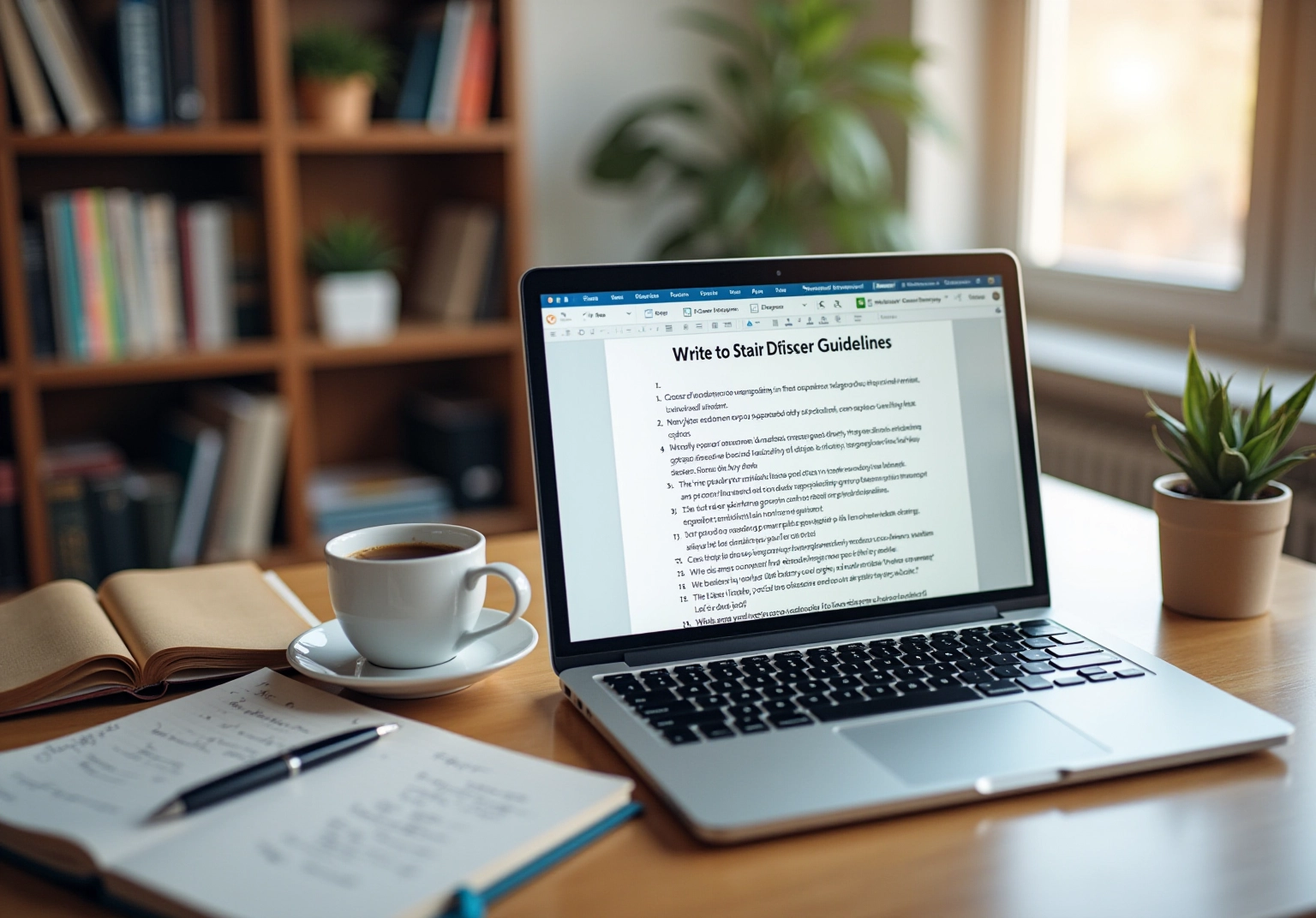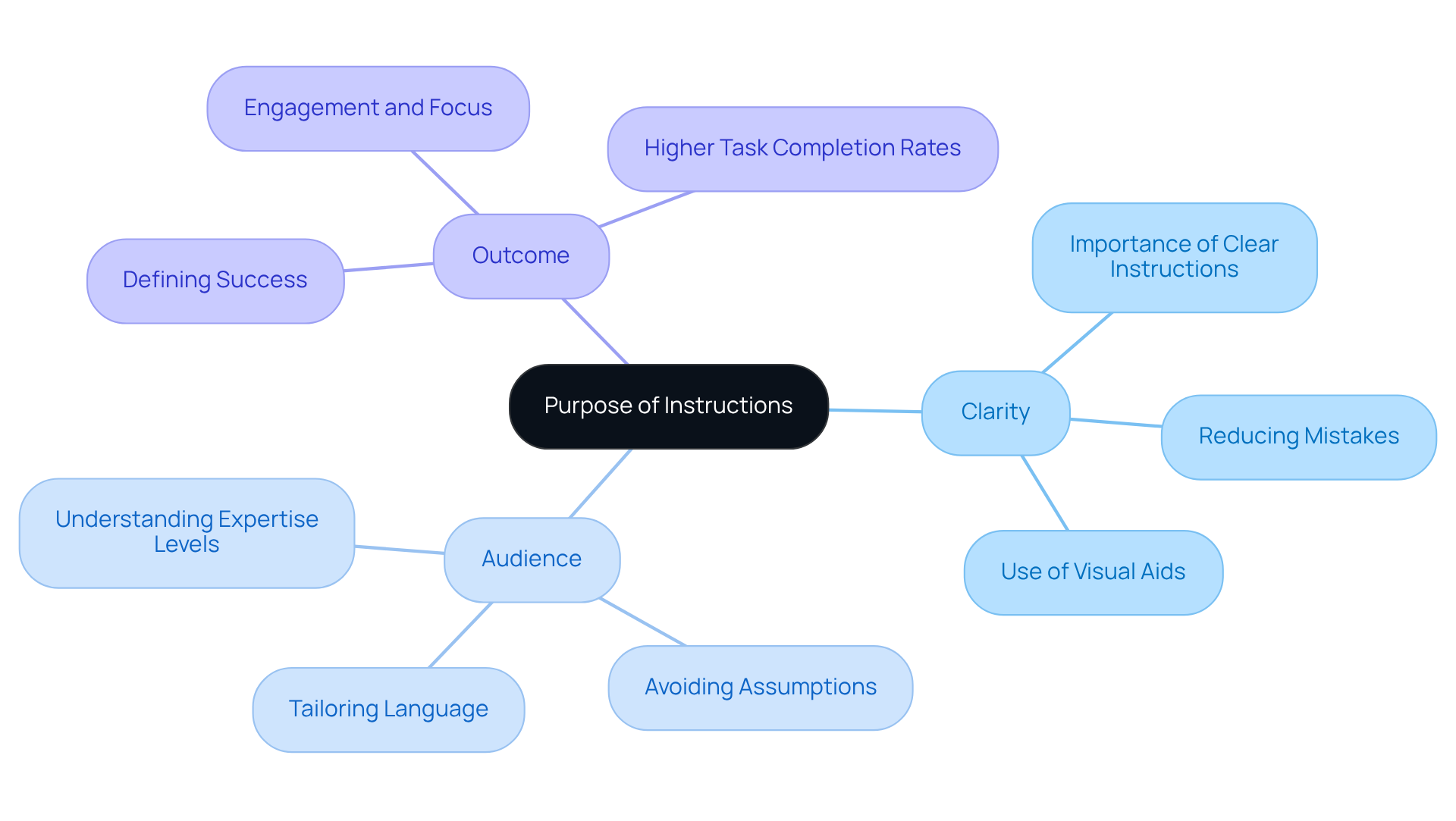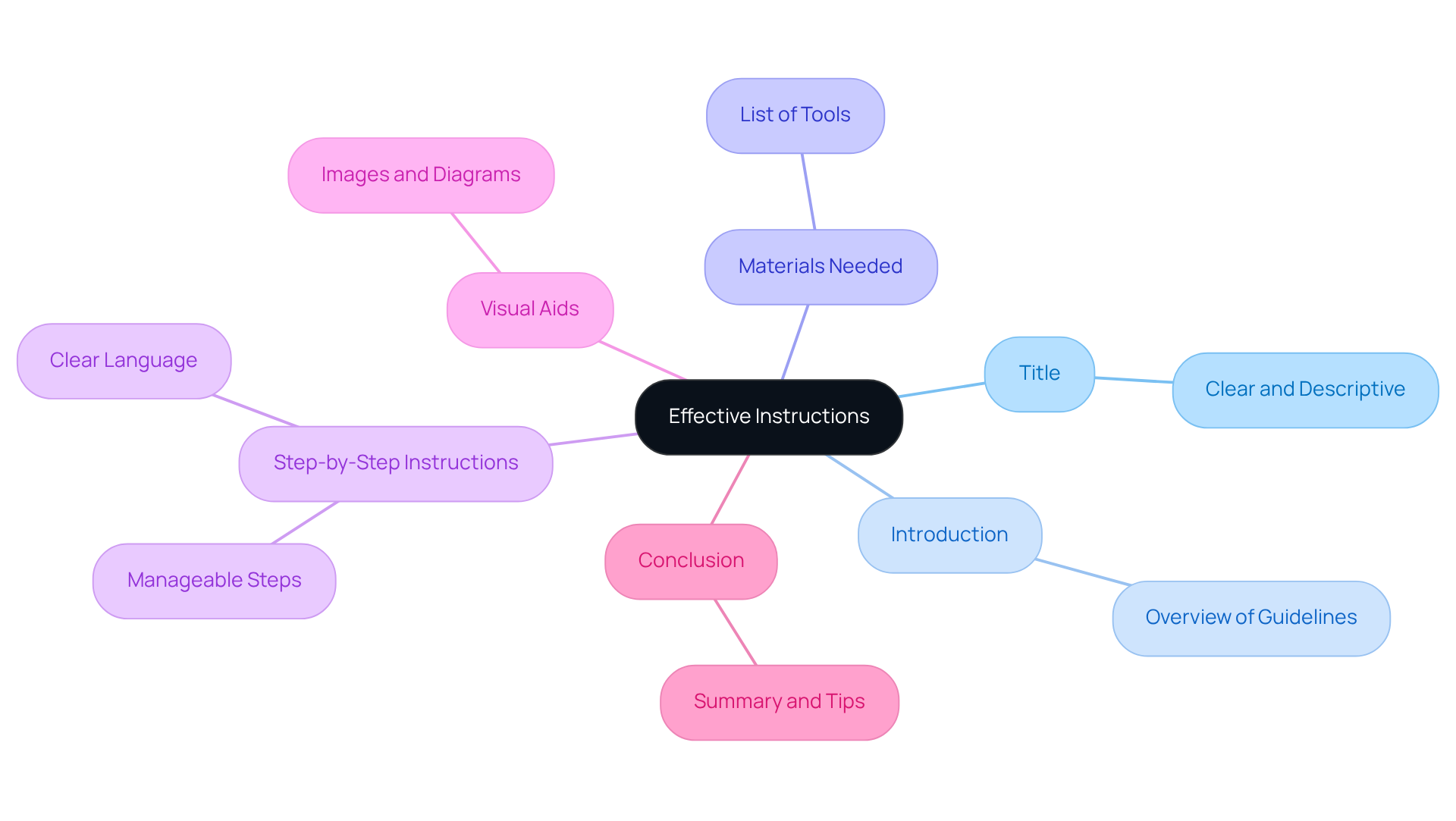
Process Improvement through Documentation
|
October 17, 2025
|
How to Write an Instructions: A Step-by-Step Approach
Overview
You might be wondering how to write effective instructions that really resonate with your audience. This article takes you through a step-by-step approach, highlighting clarity, audience understanding, and desired outcomes as the key ingredients for success. By breaking down essential elements like:
- A straightforward title
- Easy-to-follow steps
- Visual aids
it shows you how a structured process can make your documentation practices shine and help users grasp the information better. In turn, this can lead to a boost in productivity, which is something we all strive for, right? So, let’s dive into how you can make your instructions more effective!
Key Highlights:
- Instructions should be clear and concise to minimise ambiguity and mistakes.
- Understanding the target audience is crucial for tailoring language and detail.
- Clearly defining the desired outcome helps guide users effectively.
- Key components of effective instructions include a title, introduction, materials needed, step-by-step instructions, visual aids, and a conclusion.
- The process for writing instructions involves defining the task, gathering information, drafting, reviewing, evaluating, and finalising guidelines.
- Utilising tools like SowFlow, templates, visual editing tools, collaboration platforms, and feedback systems can enhance documentation practises.
- Effective documentation can significantly improve productivity and reduce financial losses associated with poor instructions.
Introduction
Crafting effective instructions is a skill that can really boost your productivity and cut down on mistakes in any task. You might be wondering how to turn those complex processes into clear, actionable steps that anyone can follow. But here’s the kicker: how do you make sure those instructions are not just easy to understand but also engaging for your audience? In this article, we’ll dive into the key elements and step-by-step processes for writing instructions that truly resonate, helping users achieve their goals with ease.
Understand the Purpose of Instructions
Before we dive into how to write instructions, let’s take a moment to understand their purpose: they’re designed to help you effectively navigate specific tasks or processes to achieve your goals. You might be wondering what key elements we should focus on:
- Clarity: It’s crucial that instructions are clear and concise—no one likes ambiguity! Studies show that having explicit guidelines can significantly reduce mistakes and boost task completion rates. When instructions are straightforward, people are less likely to misinterpret them.
- Audience: Who are you writing these guidelines for? Tailoring your language and the level of detail to fit your audience's expertise is vital. For example, using simple language can really help those who aren’t familiar with technical jargon understand what’s going on.
- Outcome: What does success look like? Clearly defining the desired outcome helps you organize your guidance effectively, ensuring everyone knows what they’re aiming for. Research indicates that when outcomes are well-defined, it leads to higher task completion rates since users tend to stay focused and engaged.
By laying down these foundational elements, you’re setting the stage for effective and user-friendly guidelines on how to write instructions. This not only makes task execution smoother but also boosts overall productivity. So, let’s get started on crafting those guidelines together!

Identify Key Elements of Effective Instructions
Effective instructions usually have a few key components that make them stand out:
- Title: You’ll want a clear title that tells folks exactly what the task is all about.
- Introduction: A quick overview of what your guidelines will cover helps set the stage.
- Materials Needed: Don’t forget to list any tools or materials people will need to get the job done.
- [Step-by-Step Instructions](https://sowflow.io): To learn how to write instructions, break things down into manageable steps, using clear and straightforward language—no one likes to feel lost!
- Visual Aids: Throw in some images, diagrams, or screenshots to make it all a bit clearer.
- Conclusion: Wrap things up with a summary of the task and toss in any extra tips or troubleshooting advice.
By including these elements, you really boost the clarity and effectiveness of your guidance. You might be wondering how to get started—just think about your audience and what they need, and you’ll be on the right track!

Follow a Step-by-Step Process for Writing Instructions
To learn how to write instructions, you might be wondering where to start. Here’s a friendly guide to help you out:
- Define the Task: First things first, let’s clearly outline what your guidelines will cover. It’s super important to ensure that the scope is well understood.
- Gather Information: Next, collect all the necessary details about the task at hand. Think about potential challenges and typical pitfalls that people might run into. It’s all about being prepared!
- Draft the Guidelines: Now, let’s get to the fun part—composing your guidelines! Focus on clarity and simplicity. Using bullet points or numbered lists can really enhance readability and make comprehension a breeze. And hey, incorporating visual aids like screenshots and diagrams can significantly boost understanding. With SowFlow, creating user guides is a piece of cake—just invoke the knowledge of your resources with a single command, and you’ll avoid those unnecessary meetings.
- Review and Revise: After drafting, take a moment to thoroughly review your work for accuracy and clarity. It’s helpful to involve someone who isn’t familiar with the task to examine the guidelines. They can provide valuable insights into possible areas of misunderstanding. Remember, regular reviews and updates are essential to keep your procedures effective, and SowFlow makes it easy to revise your documentation, ensuring it stays relevant in our fast-paced business world.
- Evaluate the Guidelines: Here’s a crucial step: put your guidelines to the test! Have someone follow them to see how they hold up. This helps identify any ambiguous parts and ensures that the guidelines effectively guide the individual through the task. Specialists in written materials say that testing guidelines can greatly enhance their efficiency, leading to higher user satisfaction and fewer mistakes. Tom Peters even points out that nearly all quality enhancement comes from simplifying methods, highlighting the importance of clarity in guidance.
- Finalize and Format: Finally, make those necessary adjustments based on feedback from the testing phase. Format your document for easy access, ensuring it’s visually appealing and aligns with your organizational branding. Consider keeping a centralized place for guidelines to boost team cooperation. With SowFlow's immediate record-keeping solution, you can simplify procedure standardization and knowledge exchange.
By following this organized method and harnessing SowFlow's capabilities, you will understand how to write instructions that are not just clear but also effective in guiding users. This will ultimately enhance productivity and operational efficiency. So, let’s get started!

Utilize Tools and Resources for Enhanced Documentation
To enhance your documentation process, you might be wondering how to write instructions that make it easier and more effective. Consider leveraging these handy tools and resources:
- Documentation Software: Have you heard about SowFlow? It’s a powerful tool for creating, managing, and updating documentation efficiently. With its intuitive interface and user-friendly Chrome extension, you can document workflows directly from your browser. This means processes are captured quickly and accurately! As Anastasia Masadi, a Product Owner, puts it, "SowFlow has been a game changer in the way we document work and deliver to our clients. I do not have to take each screenshot separately, and do not even have to leave the browser while I am creating SOPs and training materials. SowFlow gave me time from my life back." Not only does this save time, but it also contributes to a 21.3% increase in productivity, showing just how important effective documentation practices can be.
- Templates: You might find that utilizing pre-made templates for guidance saves time and ensures consistency across documents. Templates can really enhance your writing workflow, allowing you to focus on content instead of getting bogged down in formatting.
- Visual Editing Tools: Now, let’s dive into visual aids! Incorporating tools like Canva or Snagit can really improve your guidance. These tools offer clear, engaging visuals that support the written material, making it simpler for everyone to understand intricate procedures.
- Collaboration Platforms: Speaking of collaboration, platforms such as Google Docs or Microsoft Teams make it super easy for team members to work together in real time during the writing process. This collaborative approach often leads to richer content and quicker revisions, as multiple perspectives come together seamlessly.
- Feedback Tools: Establishing feedback systems is another great way to engage your team. It allows individuals to share insights on the guidelines, promoting ongoing enhancement. Regularly revising records based on feedback ensures that your documentation stays relevant and effective.
By utilizing these resources, you can simplify your record-keeping efforts, significantly improve how to write instructions, and ultimately meet user needs more effectively. Remember, effective documentation practices can help mitigate financial losses—after all, poor documentation can lead to a 21.3% productivity loss. So, investing in the right tools and strategies is definitely worth it!

Conclusion
Writing effective instructions is essential for guiding you through tasks with clarity and precision. You might be wondering how to make this process easier and more impactful. By focusing on key elements like clarity, audience awareness, and clearly defined outcomes, crafting instructions becomes much more manageable. This structured approach not only enhances your experience but also boosts productivity and cuts down on errors.
Now, let’s dive into the article's step-by-step process for writing instructions. It emphasizes the importance of:
- Defining the task
- Gathering information
- Drafting clear guidelines
- Testing their effectiveness
Incorporating tools and resources like documentation software, templates, and visual aids can really enrich your writing process, ensuring that your instructions are not just informative but also engaging and easy to follow.
In a world where effective communication is key, being able to write clear and concise instructions can significantly influence how tasks get completed and overall efficiency. By applying the insights and techniques discussed, you can elevate your documentation practices, leading to more successful outcomes and enhanced collaboration. So, why not embrace these strategies and tools? Transform how you create and utilize instructions, paving the way for improved performance and satisfaction in any task at hand.
Frequently Asked Questions
What is the purpose of writing instructions?
The purpose of writing instructions is to help individuals effectively navigate specific tasks or processes to achieve their goals.
What are the key elements to focus on when writing instructions?
The key elements to focus on are clarity, audience, and outcome.
Why is clarity important in instructions?
Clarity is crucial because clear and concise instructions reduce ambiguity, significantly lower mistakes, and boost task completion rates.
How should the audience influence the writing of instructions?
The audience should influence the writing by tailoring the language and level of detail to fit their expertise, ensuring that even those unfamiliar with technical jargon can understand the instructions.
What does defining the outcome entail when writing instructions?
Defining the outcome involves clearly stating what success looks like, which helps organize the guidance effectively and keeps users focused and engaged.
How do well-defined outcomes impact task completion rates?
Well-defined outcomes lead to higher task completion rates as they help users stay focused and engaged in the process.
👍
What others are liking
5 Steps to outline your ideal documentation structure
5 MINS READ
Where to start the your journey of mapping out your ideal documentation structure, aligning it with the very heartbeat of your organization?
Defining a winning level of detail in your process
3 MINS READ
What is too much detail, and what is too little? This article described in that winning level detail about what detail is enough.





